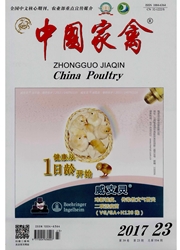

 中文摘要:
中文摘要:
本研究观察了利用秸秆覆盖对鸡舍氨气排放以及舍内环境恶臭影响效果。包括2个试验:试验一为实验室模拟,试验二为鸡舍现场测试。试验一分为11个组,鸡粪为对照组,另外分别选取不同类型秸秆材料覆盖鸡粪表面作为处理组,定期测定鸡粪氨气质量浓度,连续6d。结果表明,采用秸秆材料覆盖后各组氨气质量浓度均显著下降(P〈0.05),尤其在覆盖初期。从全程来看,经过覆盖后氨气质量浓度始终保持在26mg/m3以下的组为麦秸末组,其次为玉米秸秆末组等。试验二选择在两栋建筑类型一致的肉鸡舍进行,网上平养,每舍3900只9日龄肉鸡。试验鸡舍网下地面采用不清粪、每两天覆盖一薄层玉米秸秆方式,而对照组鸡舍采用每两天清一次粪、不覆盖方式,试验开始两舍环境温度保持在33~35℃,之后连续对比测定环境指标9d。结果表明,单独秸秆覆盖第1~4天试验鸡舍NH3和CO2质量浓度总体趋势低于对照组鸡舍(P〉0.05);第5天开始利用秸秆覆盖并且辅助喷洒微生态菌液,试验组鸡舍NH3和CO2质量浓度与对照组鸡舍相比差异仍不显著(P〉0.05),但均低于国家规定的26mg/m3标准。说明现场采用秸秆覆盖鸡粪方式来减少鸡舍氨气排放和环境影响效果,还受到多种因素的影响有待今后进一步深入研究。
 英文摘要:
英文摘要:
The study aimed to observe the effects of straw coverage on ammonia emission and environmental odor in chicken house. Two trials were arranged:trial 1 for lab simulation,and trial 2 for chicken house testing. In trial 1,there were 11 groups,chicken fece group was the control,and the other groups were covered with different types of straw materials,scattered on the surface of chicken feces,NH3 concention was measured periodically for consecutive 6 days. The results showed that NH3 concentration was significantly reduced in all groups(P0.05),especially at the initial stage of coverage. For the whole stage,groups with NH3 concentration less than 26 mg/m3 after coverage was the wheat straw powder and corn straw powder. In trial 2,two broiler houses with the same construction type were chosen,the broilers were reared with net,3 900 nine-day-age broilers per house. The feces were not cleaned,and covered with corn straw every two days in the experimental house,and the feces were cleaned once every two days,and not covered with anything in the control house. At the start of the experiment,the house temperature was kept 33 to 35 ℃,and the environmental indexes were measured and compared for consecutive 9 days for the two houses. The results showed that after coverage,NH3 and CO2 concentration of the experimental house were lower than those of the control house (P0.05)for the first 1 to 4 days;After straw coverage combined with microorganism spray at the fifth day,NH3 and CO2 concentration were not significantly different(P0.05),even there was a trend of increase,but far below the national regulation of 26 mg/m3. All these indicated that the effects of straw coverage on reducing the NH3 emission and odor in the chicken house,were affected by many factors and needed to be investigated in future.
 同期刊论文项目
同期刊论文项目
 同项目期刊论文
同项目期刊论文
 期刊信息
期刊信息
